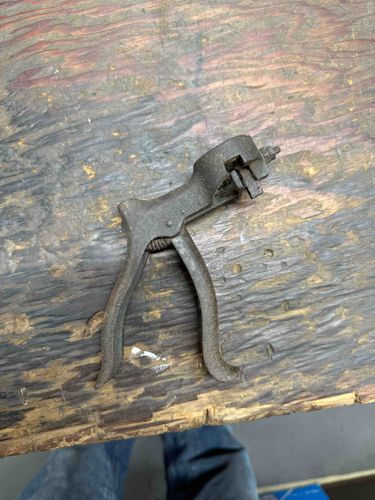
Saw Set Hand Tool
This is an antique or vintage saw set, a specialized hand tool used to bend the teeth of a saw blade alternately to the left and right, creating a 'set' that allows the saw to cut without binding. The tool appears to be constructed primarily of cast iron or steel, exhibiting a dark, uneven patina consistent with age and prolonged exposure to the elements, indicating a significant amount of surface rust and oxidation. Its overall dimensions are relatively compact, suggesting it is designed for manual operation and portability within a workshop or job site. The design features a lever-action mechanism with two handles that pivot around a central pin. Visible on the upper portion is a C-shaped jaw or clamp mechanism, with an adjustable anvil or plunger on the right side, which would engage with the saw teeth. A coiled spring is visible between the handles, providing the necessary tension for the setting action and returning the handles to their open position. The metal shows considerable wear, with pitting and discoloration across its entire surface, but no apparent major breaks or repairs are visible. The craftsmanship appears robust, typical of utilitarian tools from the late 19th or early 20th century. There are no discernible manufacturer's marks, stamps, or signatures visible in the provided image, which is common for older, less commercially branded tools or those where markings have been obscured by corrosion. The simple, functional design suggests a period where tools were built for durability and utility rather than aesthetic appeal. This tool likely represents a standard design that evolved over many years, with minimal changes.
AI-Generated Appraisal Disclaimer
Estimated Value
$30-50
Basic Information
Category
Hand Tool
Appraised On
November 28, 2025
Estimated Value
$30-50
Item Description
This is an antique or vintage saw set, a specialized hand tool used to bend the teeth of a saw blade alternately to the left and right, creating a 'set' that allows the saw to cut without binding. The tool appears to be constructed primarily of cast iron or steel, exhibiting a dark, uneven patina consistent with age and prolonged exposure to the elements, indicating a significant amount of surface rust and oxidation. Its overall dimensions are relatively compact, suggesting it is designed for manual operation and portability within a workshop or job site. The design features a lever-action mechanism with two handles that pivot around a central pin. Visible on the upper portion is a C-shaped jaw or clamp mechanism, with an adjustable anvil or plunger on the right side, which would engage with the saw teeth. A coiled spring is visible between the handles, providing the necessary tension for the setting action and returning the handles to their open position. The metal shows considerable wear, with pitting and discoloration across its entire surface, but no apparent major breaks or repairs are visible. The craftsmanship appears robust, typical of utilitarian tools from the late 19th or early 20th century. There are no discernible manufacturer's marks, stamps, or signatures visible in the provided image, which is common for older, less commercially branded tools or those where markings have been obscured by corrosion. The simple, functional design suggests a period where tools were built for durability and utility rather than aesthetic appeal. This tool likely represents a standard design that evolved over many years, with minimal changes.
Related Tags
Get Your Items Appraised
Instant estimates of your treasures with AI-powered instant appraisals